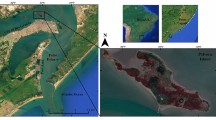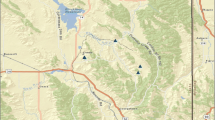Abstract
To study the possible pollution of natural waters by selenium added to agricultural fertilizers, water selenium concentrations were determined in lakes and ground water pools during the year 1992, when the enrichment of fertilizers by selenium had continued for 8 yr. Water samples were preconcentrated by evaporating, and selenium concentrations were analyzed fluorometrically using the dye 2,3-diaminonaphthalene after wet digestion. In lake water samples from 13 lakes, no significant correlations were found between selenium and pH, chlorophyll A, total nitrogen, or phosphorus. Agriculturally affected and nonaffected lakes had no differences in their selenium concentrations. In the lakes that were surrounded by cultivated fields mean water selenium was 83.4 ng/L (range: 75.2–93.4 ng/L,n=9). Correspondingly, in lakes situated in forests without agricultural surroundings, mean water selenium concentration was 76.5 ng/L (range: 51.2–110 ng/L,n=3). Only one lake in the close vicinity of a coal power plant had a high water selenium concentration (mean 272 ng/L).
In ground water samples, there was a big variation in selenium levels between different pools, the levels varying between 33 and 260 ng/L. This variation may partly be explained by different selenium concentrations of the bedrock and sediments. However, simultaneous increase of total nitrogen, phosphorus, and selenium levels in consecutive samples from some ground water pools indicates leaching of selenium from the fertilizers into the ground water in certain areas.
Similar content being viewed by others
References
T. Koljonen,Ann. Agric. Fenn. 14, 240–247 (1975).
G. Gissel-Nielsen,Acta Agr. Scand. 25, 216–220 (1975).
P. Koivistoinen,Acta. Pharmacol. Toxicol. 59, Suppl. 7, 104–110 (1986).
M. Mutanen and P. KoivistoinenInt. J. Vit Nutr. Res. 53, 102–108 (1983).
G. Alfthan,Nutr. Res. 8, 467–476 (1988).
P. Koivistoinen and J. K. Huttunen,Ann. Clin. Res. 18, 13–17 (1986).
G. Alfthan,Anal. Chim. Acta. 165, 187–194 (1984).
D. Wang, G. Alfthan, A. Aro, L. Kauppi, and J. Soveri, inTrace Elements in Health and Disease, A. Aitio, A. Aro, J. Järvisalo, and H. Vainio, eds., Royal Society of Chemistry, Cambridge, pp. 49–56 (1991).
Nordic Code Centre, Environment Data Centre, Code list DA,Analytical Determinants, G. Söderman, ed., Helsinki, version 89492-GS (1989).
T. Yläranta, Increasing the selenium content of cereal and grass crops in Finland. Ph.D. Thesis, Helsinki (1985).
T. Yläranta, Elintarvikkeiden tutkimussäätiö, publication no 17, Helsinki, pp. 25–30 (in Finnish) (1985).
E. Vuori, J. Vääriskoski, H. Hartikainen, P. Vakkilainen, J. Kumpulainen, and K. NiinivaaraAgric. Ecosystems Environ. 25, 111–118 (1989).
Author information
Authors and Affiliations
Rights and permissions
About this article
Cite this article
Mäkelä, A.L., Wang, W.C., Hämäläinen, M. et al. Environmental effects of nationwide selenium fertilization in Finland. Biol Trace Elem Res 47, 289–298 (1995). https://doi.org/10.1007/BF02790129
Issue Date:
DOI: https://doi.org/10.1007/BF02790129




